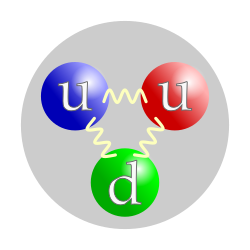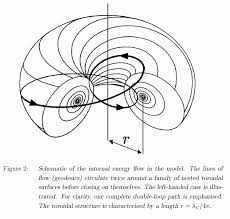Xamonas Chegwé wrote:Farsight, Your theory of mass as 'trapped light' has been repeated in numerous threads now. I won't deny that it has a certain appeal to someone that is relatively inexperienced in particle physics. You claim that the energy of a photon is 'trapped' in the body of an electron/positron pair and that it is this spinning energy that causes mass - all well and good (and please correct me if my simplification of your theory is in error)
I'd say the energy of the photon is trapped by itself, and then we call it an electron or positron. But note it isn't my theory.
Xamonas Chegwé wrote:- now here's my question. What about the other elementary particles? Quarks, leptons and their anti-particles? Are they too made up of trapped light?
Pretty much, but not quite because we don't consider neutrinos to be light. A free neutron decays into a proton, an electron and an antineutrino, and whilst the latter isn't light it moves fast and has very little mass and charge, so it does show some similarity with a photon, even though it's classed as a lepton. You can annihilate the electron with a positron to yield two gamma photons. Then you can annihilate the proton with an antiproton to get say two neutral pions which decay very rapdily into gamma photons. So you've reduced the neutron to light and an antineutrino. The quarks have totally disappeared. So whilst they're elementary particles because they're elements of a proton or neutron, they aren't elementary in the sense that they're fundamental.
Xamonas Chegwé wrote:And if so, how do you explain their different weights, spins, charges, etc. as part of your theory?
They're different stress-energy loop configurations. The mass depends on how much energy is there, the spin is a two-component rotation around a loop, and charge is the "twist" component of this. For example the proton is a trefoil configuration. Take a look at the picture below, and trace round it anticlockwise starting from the bottom left and look at the crossing-over directions.

They're up, down, and up. A proton consists of two up quarks and a down quark:

Essentially the quarks are the loops. If you imagine the trefoil is made of elastic, then if you grab it and pull, it get harder and harder to stretch it out. This corresponds to the "bag model" of quark-gluon confinement. If you were to throw rocks at this thing, the "elastic" would deform into a v shape before sending the rock flying straight back at you. This makes the quark look pointlike.
Xamonas Chegwé wrote:And what of the other bosons, the strong and weak forces, gravity?
The W and Z vector bosons have a very short lifetime and are more like "events" than particles. They're very different to photons. The strong force is like the elastic resistance to stretching, the residual strong force is "neutron linkage", and the weak interaction is akin to rotational friction. Gravity is something very different. I've got a thread on that, see
How Gravity Works. It seems to be a gradient in the relative strength of the electromagnetic force and the strong force.
Xamonas Chegwé wrote:Can these become trapped too?
No, stress energy gets trapped, and then it's a particle with mass and charge. It's important to note that there are only four stable particles with mass and charge - the electron, the positron, the proton and the antiproton. Apart from photons and neutrinos all the other "particle zoo" particles are transient. They aren't in the same league. They aren't stable configurations. They're not knots.
Xamonas Chegwé wrote:And how does your theory explain the differences in spin between bosons and fermions?
In a nutshell: a fermion is a spinning boson. It's a boson going round and round at c, but in a closed path.
Xamonas Chegwé wrote:You seem to have concentrated on one particularly familiar set of particles (photons/electrons) which are (relatively) well understood in your essays - I would be interested to see how you explain all of the others.
See above. I also describe the neutrino as a "running loop". You can emulate the particles with paper strips, and it does appear to give a coherent picture that's an improvement on the point-particle idea.





